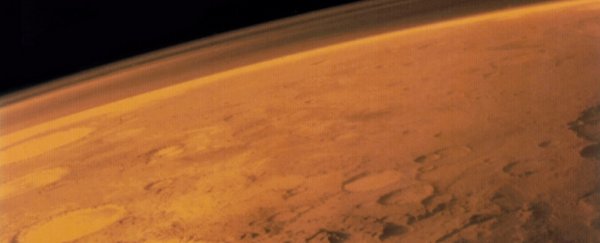New analysis of organic molecules found in dried-up Martian mud in the Gale Crater has revealed an intriguing possibility. Scientists have concluded that we can't rule out those molecules actually have a biological origin.
Although our understanding of the Martian molecules is limited and incomplete, the information we do have could be consistent with life on the Red Planet billions of years ago.
The molecules were actually extracted by the Curiosity rover from a mudstone section of the Gale Crater called the Murray Formation; a study on the finding was published in 2018. The initial experiments revealed a number of molecules, including a group of aromatic compounds called thiophenes.
Here on Earth, these compounds are usually found in some pretty interesting places. They show up in crude oil - made of compressed and superheated dead organisms such as zooplankton and algae; and coal - made of compressed and superheated dead plants.
The compound is thought to form abiotically - that is, through a physical process, not a biological one - when sulphur reacts with organic hydrocarbons at temperatures greater than 120 degrees Celsius (248°F), a reaction called thermochemical sulphate reduction (TSR).
However, while this reaction is abiotic, the hydrocarbons and sulphur can both be of biological origin. So, researchers set out to investigate how thiophenes could have formed on Mars.
"We identified several biological pathways for thiophenes that seem more likely than chemical ones, but we still need proof," said astrobiologist Dirk Schulze-Makuch of Washington State University.
"If you find thiophenes on Earth, then you would think they are biological, but on Mars, of course, the bar to prove that has to be quite a bit higher."
There are a number of ways thiophenes could have emerged on Mars without necessitating the presence of life. For instance, thiophenes have been detected in meteorites; so extramartian rocks could have carried the molecules in.
Geological processes can also produce the heat necessary for TSR, especially back when Mars was volcanically active; and volcanic activity, of course, also produces sulphur.
But there's something interesting about the Martian thiophenes. The processes described above require the sulphur to be nucleophilic, that is, the sulphur atoms donate electrons to form a bond with their reaction partner. Yet most of the sulphur on Mars exists as non-nucleophilic sulphates.
These can be reduced to nucleophilic sulphides via TSR. But there's another possibility, too - biological sulphate reduction (BSR). Some bacteria - and white truffles, too, actually, although you probably won't find those on Mars - can synthesise thiophenes.
So it's possible that when Mars was a warmer, wetter place than it is today, around 3 billion years ago, that bacterial colonies existed, and produced the thiophenes. This could occur even in below-zero temperatures. Then, when Mars dried up, the thiophenes were left there for Curiosity to dig out of the mudstone all these years later.
Sadly, the sample was a bit damaged. Curiosity uses an analysis technique called pyrolysis that heats the samples to over 500 degrees Celsius. So there's a limit to the knowledge we can glean from what survived.
But the Rosalind Franklin rover, scheduled for launch in July, will have on board an instrument that is much less destructive. So any thiophenes it digs out of the ground may be more intact when analysis is applied.
In addition, the carbon and sulphur isotopes could be revealing, too. That's because living organisms prefer lighter isotopes; if the thiophenes contain lighter isotopes, that could weight the evidence towards biological processes too.
Sadly, we probably won't know for sure based on just what our robotic friends can dig out of the ground.
"As Carl Sagan said 'extraordinary claims require extraordinary evidence'," Schulze‑Makuch said.
"I think the proof will really require that we actually send people there, and an astronaut looks through a microscope and sees a moving microbe."
The research has been published in Astrobiology.
